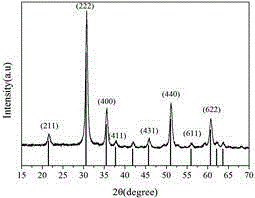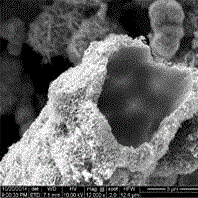Preparation method of hierarchical structured indium oxide hollow tubular gas-sensitive material
A technology of hierarchical structure and gas-sensitive material, applied in chemical instruments and methods, inorganic chemistry, gallium/indium/thallium compounds, etc., can solve the problems of difficult to meet detection requirements, low reactivity, and low gas sensitivity.
- Summary
- Abstract
- Description
- Claims
- Application Information
AI Technical Summary
Problems solved by technology
Method used
Image
Examples
Embodiment 1
[0015] (1) Take a small amount of C fiber and disperse it in deionized water, weigh a certain amount of indium chloride and L-cysteine, and dissolve them in deionized water. The concentration of indium chloride is 0.05mol / L, and the concentration of L-cysteine The concentration of cystine is 0.1mol / L, and the molar ratio of indium chloride and L-cysteine is controlled to be 1:1;
[0016] (2) Move the mixed solution obtained in step (1) to a hydrothermal reaction kettle lined with polytetrafluoroethylene, and conduct a hydrothermal reaction at a temperature of 170°C for 16 hours, and then use the product after the hydrothermal reaction The centrifuge is used for solid-liquid separation, and the obtained solid product is washed several times with deionized water and ethanol;
[0017] (3) Place the solid product obtained in step (2) in a drying oven, dry at 60°C for 24 hours, then put it in an alumina crucible and put it in a muffle furnace, and heat it at 450°C for 3 hours to ...
Embodiment 2
[0019] (1) Disperse a small amount of C fiber in deionized water, weigh a certain amount of indium chloride and L-cysteine, and dissolve them in deionized water, in which the concentration of indium chloride is 0.06mol / L, and the concentration of L-cysteine The concentration of cystine is 0.15mol / L, and the molar ratio of indium chloride and L-cysteine is controlled to be 1:1.5;
[0020] (2) Move the mixed solution obtained in step (1) to a hydrothermal reaction kettle lined with polytetrafluoroethylene, and conduct a hydrothermal reaction at a temperature of 180°C for 18 hours, and then use the product after the hydrothermal reaction The centrifuge is used for solid-liquid separation, and the obtained solid product is washed several times with deionized water and ethanol;
[0021] (3) Place the solid product obtained in step (2) in a drying oven, dry at 60°C for 24 hours, then put it in an alumina crucible and put it in a muffle furnace, and heat it at 500°C for 3 hours to ...
Embodiment 3
[0023] (1) Disperse a small amount of C fiber in deionized water, weigh a certain amount of indium chloride and L-cysteine, and dissolve them in deionized water, in which the concentration of indium chloride is 0.067mol / L, and the concentration of L-cysteine The concentration of cystine is 0.133mol / L, and the molar ratio of indium chloride to L-cysteine is controlled to be 1:2;
[0024] (2) Move the mixed solution obtained in step (1) to a hydrothermal reaction kettle lined with polytetrafluoroethylene, conduct a hydrothermal reaction at a temperature of 190°C for 20 hours, and then use the product after the hydrothermal reaction The centrifuge is used for solid-liquid separation, and the obtained solid product is washed several times with deionized water and ethanol;
[0025] (3) Place the solid product obtained in step (2) in a drying oven, dry at 60°C for 24 hours, then put it in an alumina crucible and put it in a muffle furnace, and heat it at 500°C for 3 hours to obtai...
PUM
 Login to View More
Login to View More Abstract
Description
Claims
Application Information
 Login to View More
Login to View More - R&D
- Intellectual Property
- Life Sciences
- Materials
- Tech Scout
- Unparalleled Data Quality
- Higher Quality Content
- 60% Fewer Hallucinations
Browse by: Latest US Patents, China's latest patents, Technical Efficacy Thesaurus, Application Domain, Technology Topic, Popular Technical Reports.
© 2025 PatSnap. All rights reserved.Legal|Privacy policy|Modern Slavery Act Transparency Statement|Sitemap|About US| Contact US: help@patsnap.com



